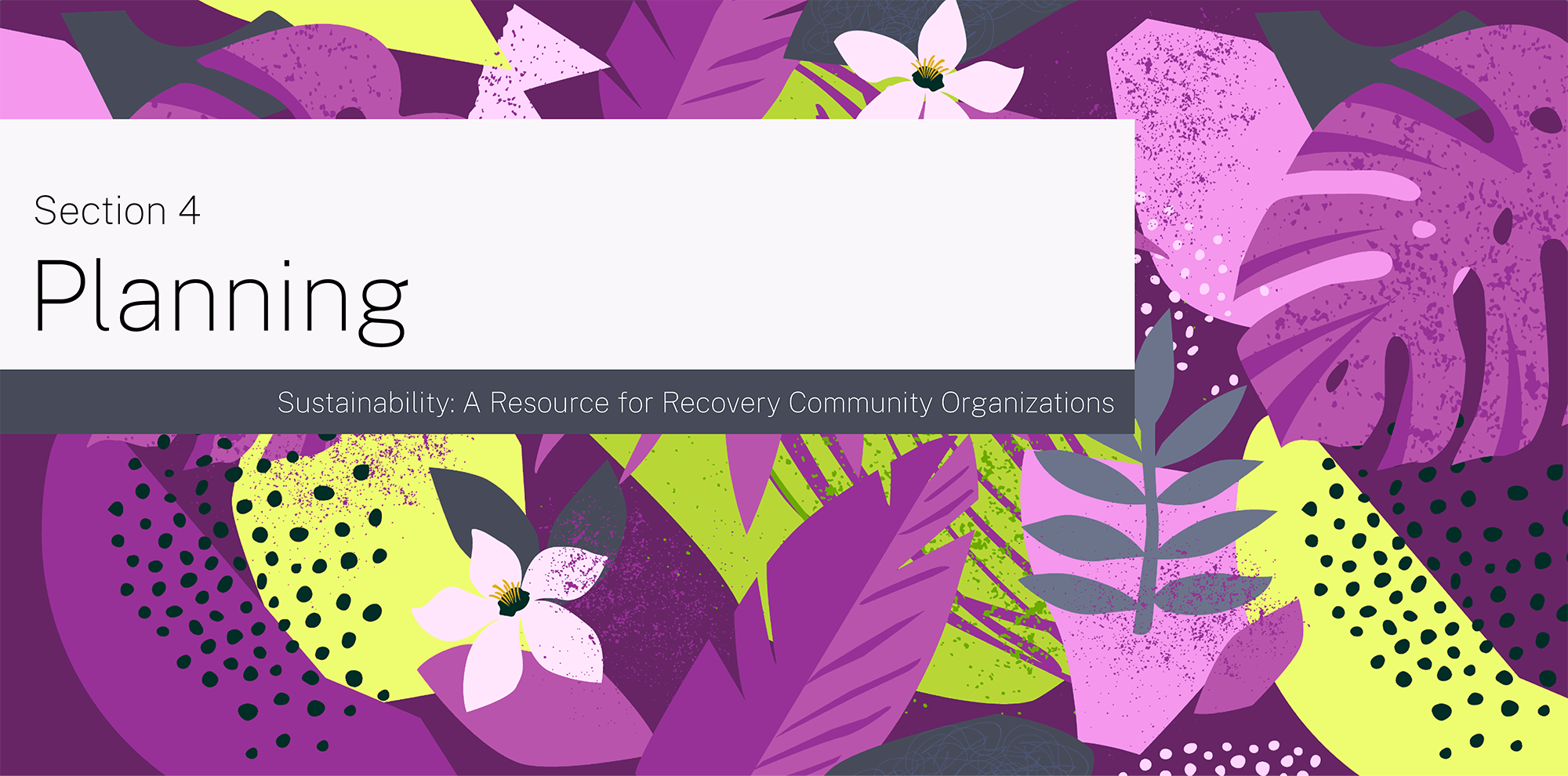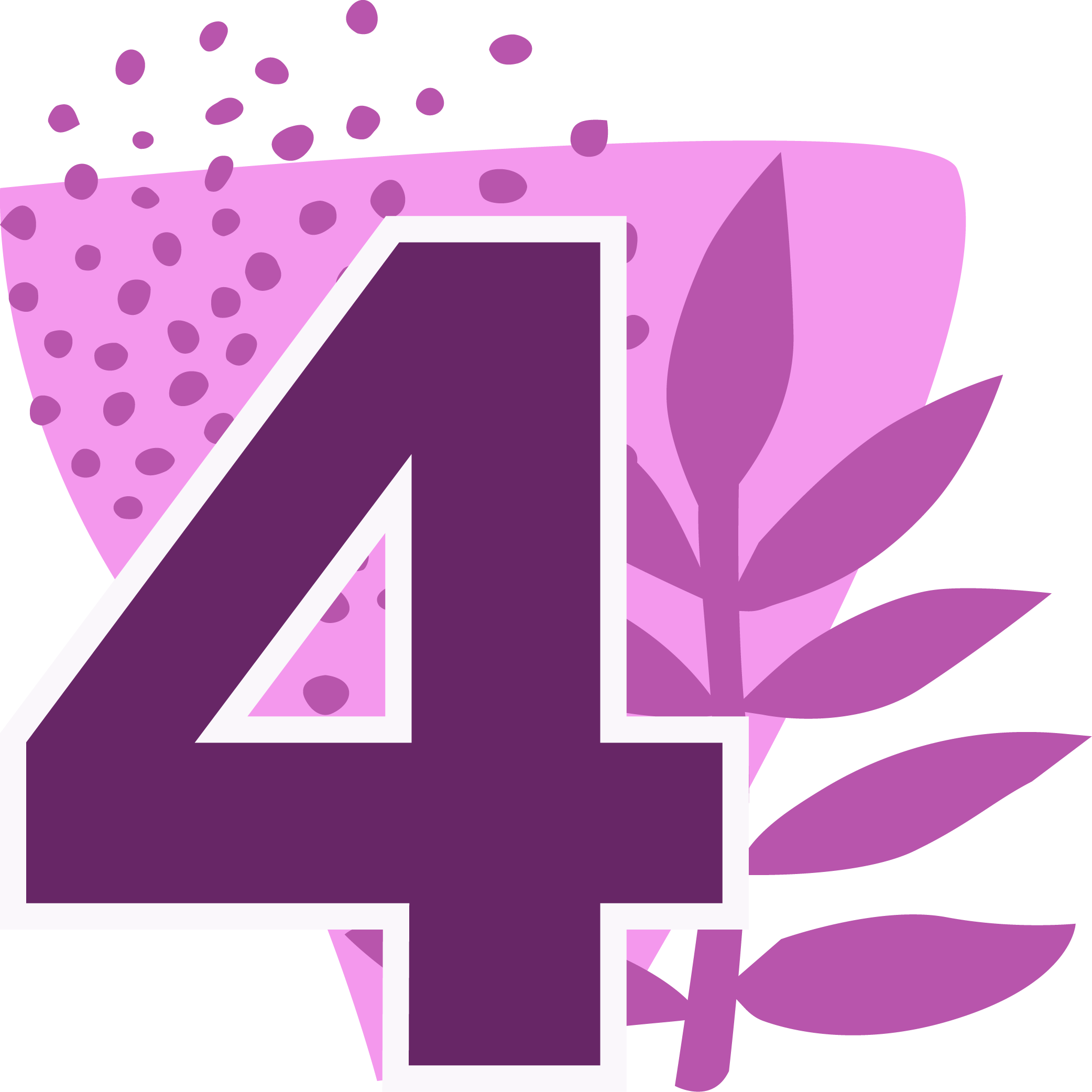
Section 4: Planning
In this section, you’ll learn why organizational planning is useful and how it supports sustainability.
Planning is a part of an RCO’s sustainability and ongoing success. It’s a process that often involves setting goals, determining strategies, and allocating resources to achieve the mission of the organization. In RCOs, planning is completed through deep collaboration with partners and stakeholders. Prioritizing planning processes, be it strategic planning, program planning, or developing work plans, will help an RCO to stay on track toward their goals and avoid losing sight of their mission.
As a leader, ask yourself these questions as you move through this Section:
- How am I regularly taking time out of my daily work to reflect upon where the RCO is headed based on the work we are doing?
- How am I asking staff and volunteers about where they think we are headed, or where they would like to see us going?
- How can we integrate stakeholder feedback and voices into our reflection and planning processes?
- What tools and processes for planning are most aligned with my organizational culture and will help us develop the plans or decisions we need right now?
Types of Planning
Organizational planning, strategic planning, program planning, work plans, and event planning are all different types of planning processes that RCOs can use to achieve their goals and objectives. Not all types of planning are useful to an RCO and different types of planning are used for different purposes. Many people shutter at the mention of “strategic planning”; Hopefully with a better understanding of all the styles of planning available, your RCO can start small and add more as the RCO grows.
Here is an explanation of each:

Organizational Planning: This is the process of setting overall goals and objectives for an organization. It involves defining the mission, vision, values, and strategies of the organization to provide a clear direction and roadmap for success.

Strategic Planning: Strategic planning focuses on setting long-term goals and formulating strategies to achieve them. It involves analyzing the internal and external environment, identifying opportunities and threats, and aligning the organization's resources and capabilities with its long-term objectives.

Annual Planning: Annual planning is a type of planning that organizations undertake once a year to set goals, allocate resources, and define priorities for the upcoming year. It involves reviewing past performance, identifying areas for improvement, and developing action plans for achieving desired outcomes.

Program Planning: Program planning involves designing and implementing specific initiatives or programs to achieve the organization's goals and objectives. It includes identifying activities, resources, and timelines for each program, as well as desired outcomes and indicators of success.

Work Plans: Work plans outline tasks, activities, and timelines needed to complete specific projects or deliverables. They break down large goals into manageable steps, assigning responsibilities and providing a roadmap for project execution.

Event Planning: Event planning involves organizing and managing various events, such as conferences or celebrations. It includes defining event objectives, selecting venues, coordinating logistics, managing budgets, and ensuring successful execution.
Organizational Mapping Tool
Sometimes it is hard to know where to start with planning. RCOs can use the Organizational mapping tool from the Ford Foundation to recognize their strengths and areas that need improvement.
“The Organizational Mapping Tool (OMT) was created to help the staff of an organization reflect and build on its strong points and identify areas for institutional strengthening by fostering organization wide discussion. This survey provides the opportunity for your organization to consider itself as a whole, asking what works well and what could be improved. It then helps you collectively identify priority areas for improvement and steps for addressing them.”
Strategic Planning
Our strategic or organizational plan is how old?! Let’s put some planning time on our calendars, leadership team and board!
A strategic plan is the documentation of a series of reflection, brainstorming, and decision-making discussions that outlines where an RCO is going to focus its efforts in the next 1, 3, or 5 years. It involves reflection, brainstorming, and decision-making discussions to determine the RCO’s vision for the future. By identifying energizing, mission-oriented, and actionable strategies, strategic planning strengthens the RCO. There are a lot of ways to develop a strategic plan, and none are wrong if they help staff, volunteers, and other stakeholders get excited about, aligned with, and ready to work collaboratively toward the RCO’s future.
Strategic planning illuminates the present, envisions the future, and maps a realistic path between the two. When the entire team including staff, board, and community members, is involved and energized, strategic planning can be transformative. RCOs that can plan well are strong, responsive, adaptive, and vibrant, as everyone understands where the ideas came from, how their work fits into the plan, and what they are doing to advance the RCO's big picture efforts.
Strategic planning is frequently mentioned in the nonprofit sector, as funders, board members, staff, and community members seek clarity on the RCO's direction. While having a strategic plan, framework, or vision helps make crucial decisions, it may not address every moment of tension or confusion. Strategic plans prioritize efforts and energy but do not provide a detailed work plan or address day-to-day specifics. These specifics come after the strategic plan is developed.
Strategic planning will help you identify the changes you want or need to make in the RCO to achieve your vision for your community. Though the process may feel slow or burdensome, the ideas and alignment generated are invaluable and worth the time and effort.
Strategic thinking extends beyond formal strategic planning. RCO leaders should take moments to pause, reflect, and strategically plan throughout their journey. Instead of rushing from one idea or program to another, valuable lessons and insights from past opportunities should inform the RCO's direction. Assess the immediate and long-term needs of the RCO and find suitable tools and resources to fulfill those needs.
Resource: Take a look at these tools for Strategic Planning BoardSource’s 5 Phases of Strategic Planning and Strategic Planning in Nonprofits
Implementation, Annual, and Quarterly Planning
Are our implementation plans documented and accessible to all staff? Who is included in the planning process? Do we review these plans to measure our progress or need to reevaluate?
A strategic plan is like a roadmap for an RCO's future. It outlines the focus areas for the next 1, 3, or 5 years and how those strategies align with the RCO's mission and vision. It provides a clear vision of where the RCO wants to go and highlights some of the paths it will take to get there. However, it doesn't include all the specific actions needed to achieve the strategic plan. Those details are found in the zoomed-in plans that focus on different aspects of the strategic plan's timeline.
Implementation plans Implementation plans take the strategic plan and narrow its focus to a specific timeframe, such as 12 or 18 months. This plan requires the involvement of staff and board members to identify what needs to be accomplished during that time to move the RCO closer to achieving its strategic plan. These accomplishments should be specific and measurable. What are the specific goals you want to achieve in the next 12 months?
Once the goals are defined, the team discusses how each accomplishment represents progress towards the overall strategic plan. Then, they determine when these goals will be completed and outline the necessary action steps.
Resource: If you're looking for guidance on creating an implementation plan, here is an Implementation Plan Template and Examples from the Collaborative for Implementation Practice.
Annual plans can include a 1-year implementation plan and any other plans that address the areas of effort and progress an individual or team anticipates working on. Even if your RCO doesn't have a strategic plan, you can still create an annual plan. Annual planning is when leaders outline their team's strategy for the upcoming year, identifying what they want to achieve by the end of the year and developing a roadmap of actions, decision points, and budget elements to guide them. If you need a template to assist you in annual planning, we have an annual planning template available from Asana that can help you get started. Plus, using Asana can be a helpful tool for your RCO!
To ensure successful execution, both implementation plans and annual plans should be broken down into quarterly plans. For example, let's say your annual goal is to create an Employee Handbook, and you believe it will take the entire year to complete. Breaking it into quarters allows you to allocate your time wisely. You might have limited availability in Q1 due to a big fundraiser, so you can dedicate that time to researching other RCO's handbooks for inspiration. In Q2, with more time available, you can focus on drafting 80% of the manual, but be sure to protect that time or it may slip away. Q3 might be challenging due to National Recovery Month activities, so you'll need to allocate time in Q4 to finish drafting, review the handbook, gather feedback from reviewers, and make final edits before launching it with your staff.
Remember, every step you take, big or small, brings you closer to your goals. By breaking them down into manageable chunks and planning strategically, you set yourself up for success in realizing your RCO's vision and making a positive impact in the recovery community.
Words of Wisdom from the Field - Sean O’Donnell, executive director, Foundation for Recovery
“I've had the opportunity to serve as the executive director of Foundation for Recovery, Nevada's statewide recovery community organization, since fall of 2020. I joined the organization during a time of transition, growth, and many uncertainties, like the COVID-19 pandemic. My advice for any new leader of a recovery community organization is to plan, set realistic expectations, be a generalist, not a specialist, remain teachable, and let the community and data drive your decisions.
When approaching planning for your organization, consider starting with feedback from the community and trends in data. Organize town halls, listening sessions, and interviews with members of your community. Listen to their stories, grievances, and successes. Send surveys to partners, providers, and other organizations in the area. Gather feedback on how your organization can help meet a need and coordinate with other advocates and agencies. Combine this information with reliable data from your county, state, local universities, and other reputable sources. You'll notice trends emerge that can help guide you in planning.
Similar approaches have helped provide clarity to me in my role, along with our team and our board. What I hope you take away is that involving the community in the planning process is crucial. Once you have a plan, I caution any leader from simply dictating the goals to staff and volunteers. Ensure they are part of the process at every step and have an opportunity to provide their own insights and have ownership over parts of the process and recognize them for their contributions. Realize what is doable now, and what can wait. What do you need in order to achieve a goal? Money, people, more knowledge or expertise? When can you get those things? This year, next year, within 5 years? You never want to be in a position where you are spread too thin - it's not a fun place to be.
I'll leave you with two other pieces of advice.
Remaining teachable has been an important lesson for me in my role. It feels good to be knowledgeable, but try to never be the smartest person in the room. Surround yourself with people who have been doing this longer, know more, and can help you grow in your abilities. Ask "why"... a lot. And on a related note, be a generalist, not a specialist. What I mean by this is that you will be responsible for wearing many hats. You may need to know a thing or two about accounting, public speaking, human resources, marketing and public relations, advocacy, public policy, government relations, grant writing, fundraising, event planning, program development and evaluation, insurance, leases, enough to make your head spin.
"Wait, didn't I get into this because I just want to help people? I didn't sign up for all of this." Yes, but don't let it intimidate you. In my first year and a half leading an organization I would often find myself overwhelmed with all the things that I didn't know. I would dive deep into trying to learn everything instead of focusing on what I did know. What I knew how to do was to bring people together. I am resourceful. Attributes that most leaders probably have. I received this advice from a colleague and board member, "be a generalist, not a specialist". This advice helped me to reframe and instead focus my time and energy finding people, the specialists, that know more than I do to help advise and guide me in my role so I can lead more confidently. I still strive to learn as much as I can but I don't need to be a specialist in all these areas.
I hope my experience is helpful for you as you begin planning for the sustainability of your organization. You got this.”
Program and Work Plans
The main difference between a program plan and a work plan lies in their scope and level of detail.
Program Plan:
- Scope: A program plan provides an overview of a broader program or project within an RCO. It outlines the goals, objectives, strategies, activities, and timelines for the entire program.
- Level of Detail: Program plans are higher-level documents that focus on the big picture and strategic direction of the program. They may include information on stakeholders, budget, evaluation criteria, and potential risks.
- Purpose: The purpose of a program plan is to define the overall strategy and objectives of a program, establish benchmarks for success, and guide the implementation of multiple related projects or activities.
Work Plan:
- Scope: A work plan, on the other hand, is more focused and detailed. It outlines specific tasks, activities, responsibilities, timelines, and resources required to achieve a particular objective or goal within a program.
- Level of Detail: Work plans are more granular and operational, breaking down the tasks into actionable steps that need to be completed by individuals or teams. They provide a roadmap for day-to-day activities and progress monitoring.
- Purpose: The purpose of a work plan is to guide the implementation of specific tasks and activities, allocate resources efficiently, track progress, and ensure that goals are met within a specific timeframe.
To put it simply, a program plan sets the strategic direction and goals for a larger program or project, while a work plan focuses on the operational details and specific tasks needed to achieve a particular objective within that program. Both documents are helpful for effective planning and execution in RCOs.
Program Planning
What are the needs and interests of the community we serve? What resources do we have? What resources do we lack?
At the heart of RCOs' mission and impact are the programs that offer essential resources and support. However, creating a clear program plan that aligns with organizational goals, available resources, and stakeholder involvement can be a complex task. Following an initial round of funding, typically provided by the Single State Agency (SSA), a foundation, or small community development grant, RCOs often struggle in securing continued financial support. Many RCOs start to actively seek out grants to sustain their organization’s operations, which can lead to shifts in the focus of their programs or “mission creep”. With this being the case, the importance of deliberate and thoughtful program planning becomes even more critical.
Key elements of program planning include identifying the target audience, defining the goals of the program, allocating necessary resources, and setting timelines.
- Identifying the Target Audience: This step involves understanding who the program is designed to serve. It requires a deep understanding of the community's needs and the specific challenges they face.
- Defining the Goals of the Program: The program goals need to align with the overall mission of the RCO and aim to address the specific needs identified in the target audience. This step provides direction and purpose to the program.
- Allocating Necessary Resources: Resources include not only financial allocations but also human resources, time, and any other inputs needed for the program's implementation. Effective planning ensures that these resources are used efficiently and effectively.
- Setting Timelines: Timelines provide a framework for program implementation and help track progress. They also allow for timely adjustments if needed.
- Evaluating Program Success: This involves setting up mechanisms to measure program outcomes and assess whether the program is achieving its intended goals. This could include regular reviews, feedback sessions, or more formal evaluations. It is important to know when a program is working and when adjustments need to be made.
Resource: Program Plan Template from Beyond the Bell
Sample Program Plan Outline
Below is an simplified example of of a program plan for embedding Peer Recovery Support Services in an Emergency Department:
- Identify the Target Audience: The target audience for this program would be individuals who have been admitted to the Emergency Department and are in need of recovery support services.
- Define the Goals of the Program: The goal of this program is to provide immediate recovery support to individuals admitted to the Emergency Department, helping them navigate the healthcare system and connecting them with community recovery resources.
- Allocate Necessary Resources:
- Staff: We will need to hire or train Peer Recovery Specialists who have lived experience of recovery.
- Training: Training will need to be provided to the Peer Recovery Specialists to ensure they are equipped to support individuals in an Emergency Department setting. Training will also need to be provided to Emergency Room staff to ensure they understand the role of the Peer Recovery Specialists and the goals of the program.
- Partnerships: We will need to build relationships with the Emergency Department staff and local recovery resources.
- Funding: We will need to secure funding to support the salaries of the Peer Recovery Specialists and operational program costs.
- Set Timelines:
- Staff Hiring/Training: To be completed within the first two months.
- Program Implementation: To begin in the third month after hiring and training are complete.
- Ongoing Review and Adjustments: To be conducted on a monthly basis once the program is implemented.
- Evaluate Program Success:
- Weekly check-ins with Peer Recovery Specialists to discuss challenges and successes.
- Monthly reviews of program data (number of individuals served, types of support provided, referrals provided, etc.)
- Quarterly formal evaluation to assess the program’s impact on individual recovery outcomes.
Call out box
Organizing Programs
How can organizing our programs into categories improve our operations and impact? How can we communicate the purpose and outcomes of our programs?
A beneficial strategy for newer RCOs is to view their programs in distinct "buckets" for easier communication with funders, stakeholders, and the community at large. As RCOs expand their activities, it can be challenging to convey the overall impact or advocate for support when the activities appear somewhat similar. By distinguishing core program areas, such as Family Programs, Justice Involved Programs, Public Education Programs, etc., and then providing specific examples of activities, you can tell a more compelling story. This approach can also help communicate your organization's niche or specific areas of expertise.
For instance, an RCO might have a "Youth Programs" bucket that includes activities like peer mentorship, school outreach, and recreational events for young people in recovery. By grouping these activities under a common theme, it's easier to explain the program's scope and impact.
Similarly, an "Employment Support Programs" bucket could encompass services like skills workshops, resume building sessions, and job placement assistance for those in recovery. This makes it more straightforward to convey the overall purpose and value of these initiatives to potential funders or supporters.
By organizing your activities into these distinct categories, you not only create a clearer picture of your organization's work for outsiders but also for the team itself. It can help in keeping the vision and goals aligned, and also ensure that resources are evenly distributed among different areas.
Remember that how you categorize your programs should reflect the unique mission and strengths of your RCO. While it's helpful to have general categories like "Family Programs" or "Public Education Programs," don't shy away from creating categories that are specific to your RCO's unique programs.
Resource: Center for Public Health Systems Science at Brown School at Washington University offers a wealth of free capacity building tools. Check out the Program Sustainability Assessment Tool as a starting point.
Work Plans
How do we determine what resources (financial, human, and material) are needed for this program or project? Do we know who will be responsible for different aspects of this project?
Developing work plans involves breaking down the RCO's overall goals and objectives into specific, measurable, achievable, relevant, and time-bound (SMART) tasks and activities.
Here's a step-by-step approach to developing work plans:
- Review the strategic plan or program plan: Start by thoroughly understanding the RCO's strategic plan or program plan. Identify the key priorities and strategies outlined in the plan.
- Identify objectives: Break down the strategic plan or program plan priorities into objectives. Objectives should be specific, measurable, achievable, relevant, and time-bound (SMART).
Example, if the strategic plan identifies enhancing community outreach and engagement as a priority, the work plan objective might be to increase community engagement by 30% over the next year through hosting a series of 12 community events.
- Define tasks and activities: Break down each work plan objective into individual tasks and activities. Identify what needs to be done to achieve each objective.
Example: Plan a series of community events such as workshops, forums, and social gatherings, develop a schedule for these events throughout the year, and coordinate event logistics like location, supplies, and guest speakers.
- Assign responsibilities: Assign responsibilities for each task or activity to individuals or teams within the RCO. Ensure that there is clarity on who is accountable for each task and who will provide support.
Example: Assign the event planning and scheduling to the Peer Advisory Council, the marketing person/team will be responsible for promoting the events through various channels, and the administrative person/team will handle the event logistics
- Set timelines: Determine realistic timelines for each task or activity. Create a timeline that outlines the start and end dates for each task, as well as any intermediate milestones. This will help in tracking progress and staying on schedule.
Example: In general, event planning should begin 3 months before the event, promotion should start 6 weeks before the event, and final logistics should be confirmed 2 weeks prior to each event.
- Allocate resources: Identify and allocate the necessary resources such as staff, budget, and equipment needed to accomplish each task.
Example: Allocate a portion of staff time to work with the Peer Advisory Council on scheduling and planning, set aside a portion of the marketing budget for event promotion, and ensure the administrative person/team has the necessary resources for setting up each event (i.e. food/beverage, equipment, venues)
- Monitor and evaluate: Regularly monitor the progress of each task and evaluate the effectiveness of the work plans. This can be done through regular team meetings, progress reports, and simple spreadsheet tracking.
Example: Track event attendance and community feedback after each event, evaluate the effectiveness of each event in increasing community involvement and awareness, adjust plans for future events based on these evaluations.
- Adjust as needed: As the RCO progresses with the implementation of the work plans, it is important to be flexible and adaptable. Adjustments may be necessary based on changing circumstances or lessons learned along the way.
Resource: Try out this Work Plan Template starting with one key priority from your strategic plan.
Event Planning
Do we host events that would run more smoothly with an event planning process in place?
Events are a way for RCOs to bring people together, create meaningful connections, and advocate for the recovery community. By hosting regular events, an RCO can foster a sense of belonging and empowerment within the recovery community, building a strong sense of community. These events provide an opportunity to educate the public about substance use and the benefits of recovery, helping to reduce stigma and promote understanding and empathy.
Events also serve as a powerful platform for advocating for policy change and improving access to resources. By bringing together individuals in recovery, their families, and policy makers, events facilitate meaningful conversations and inspire action to drive systemic change.
Additionally, events often provide an opportunity to raise much-needed funds for an RCO's initiatives and engage the broader community, breaking down barriers and creating opportunities for individuals to get involved, learn, and become allies in the recovery movement. With a well-established event planning process, the RCO can streamline logistics, ensure effective communication, and empower its volunteers and supporters to contribute their gifts, skills, and talents.
Events or major actions that might involve a lot of moving parts require a level of detail, attention, and management that might not be a standard part of an RCO’s practice. By using a planning process and involving everyone who will be responsible for leading different aspects of the event, RCOs can help the team focus and manage their efforts successfully. Read this article from Donorbox, Nonprofit Event Planning: 9 Simple Steps that will help you think through the details and work as a team to put on a fantastic event!

Section 4: Pause & Reflect
At the end of each section, take time to reflect on what was presented, consider how it applies to your unique situations, structures, and goals of your RCO, and identify possible next steps.
At the end of each section, take time to reflect on what was presented, consider how it applies to your unique situations, structures, and goals of your RCO, and identify possible next steps.
- What information or ideas were new, interesting, helpful, or hopeful in this section?
- How does this section guide your organization in adapting, improving, or building upon the RCO Guiding Principles and Practices listed below? For each point, consider "What is going well?" and "What could be better?"
- Led and governed by members of the recovery community
- Grassroots, local, community-based decision-making
- Participatory practices are emphasized, promoting community involvement and collaboration.
- All pathways and recovery journeys are honored and celebrated
- Diverse, equitable, and inclusive policies, practices, and services
- Recovery oriented language that is strengths-based and person-centered
- What areas of your organization do you think might need some work or review?
- What is one small step you can take in the next 2–3 weeks to begin doing that work or review? (This could be emailing someone to schedule a meeting, finding and printing the most up to date draft of something, or asking someone to review draft language.)

CAPRSS Considerations
At the end of some sections in this guide, you will find a segment titled “CAPRSS Considerations”. These segments highlight particular aspects of Council on Accreditation of Peer Recovery Support Services (CAPRSS) standards that relate to the section topic. See the paragraph below for more information on pursuing CAPRSS accreditation.
A solid organizational infrastructure defines governance roles and processes and establishes authority and decision-making procedures that help recovery community organizations be accountable to the community and funders.
Organizational and strategic planning and intentional programmatic development strategies that align with community assets and needs have a measurable impact on an organizations’ success and sustainability.
Data and evaluation efforts, both within programs and during strategic planning connect with CAPRSS's focus on measurable impact, which underlines the role of evaluation in identifying gaps, celebrating successes, and strengthening peer recovery support services within the community.
These are reflected in CAPRSS’s practices-related standards of Program Oversight, Organizational Policies and Practices in the domain of Governance of Program oversight. As well as Quality Assurance and Cultural Competence in the Management Systems domain and Determining Community Strengths and Needs, Planning, Offering Support, and Evaluating the Supports / Services in the performance-related standards of the Peer Support: Core Competencies domain.


